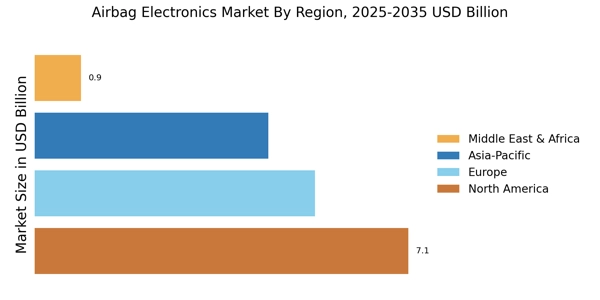Rising Vehicle Production
The Airbag Electronics Market is experiencing a notable surge due to the increasing production of vehicles worldwide. As manufacturers ramp up their output to meet consumer demand, the integration of advanced safety features, including airbag systems, becomes paramount. In 2025, the automotive sector is projected to produce over 90 million vehicles, which directly correlates with the demand for airbag electronics. This trend is further fueled by regulatory requirements mandating enhanced safety measures in vehicles, thereby driving the growth of the airbag electronics segment. Consequently, manufacturers are investing in innovative airbag technologies to ensure compliance and improve safety ratings, which is likely to bolster the Airbag Electronics Market significantly.
Stringent Safety Regulations
The Airbag Electronics Market is significantly influenced by stringent safety regulations imposed by governments and regulatory bodies. These regulations mandate the inclusion of advanced airbag systems in new vehicles, thereby driving the demand for airbag electronics. In many regions, compliance with safety standards such as the New Car Assessment Program (NCAP) is essential for vehicle manufacturers. As a result, automakers are compelled to invest in high-quality airbag electronics to meet these requirements. The increasing focus on passenger safety is likely to propel the market forward, as manufacturers strive to enhance their safety ratings and avoid penalties associated with non-compliance. This regulatory landscape is expected to create a robust environment for growth within the Airbag Electronics Market.
Growth of Electric and Autonomous Vehicles
The emergence of electric and autonomous vehicles is reshaping the Airbag Electronics Market. As these vehicles become more prevalent, the need for advanced safety systems, including airbags, is becoming increasingly critical. Electric vehicles often feature unique designs and structures, necessitating the development of specialized airbag systems that can accommodate these changes. Furthermore, autonomous vehicles require sophisticated airbag technologies that can adapt to various driving scenarios. The market for airbag electronics is expected to witness substantial growth as manufacturers innovate to meet the safety requirements of these new vehicle types. This shift towards electric and autonomous vehicles is likely to create new opportunities within the Airbag Electronics Market.
Technological Advancements in Airbag Systems
Technological advancements play a crucial role in shaping the Airbag Electronics Market. The integration of smart sensors and advanced algorithms enhances the functionality and reliability of airbag systems. For instance, the development of adaptive airbags that adjust deployment based on the severity of a collision is gaining traction. This innovation not only improves passenger safety but also aligns with the growing consumer expectation for high-tech safety features in vehicles. As automakers increasingly adopt these technologies, the demand for sophisticated airbag electronics is expected to rise. The market for airbag electronics is projected to reach approximately USD 10 billion by 2026, reflecting the impact of these technological advancements.
Consumer Awareness and Demand for Safety Features
Consumer awareness regarding vehicle safety is on the rise, significantly impacting the Airbag Electronics Market. As individuals become more informed about the importance of safety features, the demand for vehicles equipped with advanced airbag systems is increasing. Surveys indicate that a substantial percentage of consumers prioritize safety features when purchasing a vehicle, leading manufacturers to enhance their offerings. This trend is further supported by marketing campaigns emphasizing the benefits of advanced airbag technologies. Consequently, automakers are investing in the development of innovative airbag electronics to cater to this growing consumer demand. The heightened focus on safety is likely to drive the expansion of the Airbag Electronics Market in the coming years.


















Leave a Comment